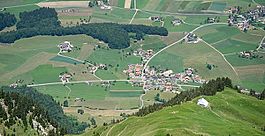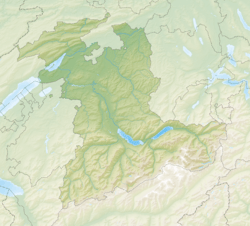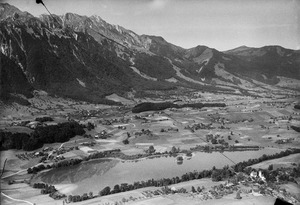Oberstocken facts for kids
Quick facts for kids
Oberstocken
|
||
|---|---|---|

Oberstocken village from the peak of the Stockhorn
|
||
|
||
| Country | Switzerland | |
| Canton | Bern | |
| District | Thun | |
| Area | ||
| • Total | 4.1 km2 (1.6 sq mi) | |
| Elevation | 691 m (2,267 ft) | |
| Population
(Dec 2011)
|
||
| • Total | 277 | |
| • Density | 67.6/km2 (175.0/sq mi) | |
| Postal code |
3632
|
|
| Surrounded by | Därstetten, Erlenbach im Simmental, Höfen, Niederstocken, Pohlern | |
Oberstocken was once a small town (or municipality) in the Bern area of Switzerland. It was part of the Thun district. On January 1, 2014, Oberstocken joined with two other towns, Niederstocken and Höfen, to form a new, larger town called Stocken-Höfen.
Contents
History of Oberstocken
Oberstocken was first mentioned in old records in 1351. Back then, it was called Stogken.
During the Middle Ages (a long time ago, from about 500 to 1500 AD), Oberstocken was part of the lands owned by a group of priests (called canons) from Amsoldingen. In 1485, the job of these canons ended, and the powerful city of Bern took over their lands.
In 1505, Oberstocken became part of Bern's Thun district. It stayed that way until 1803. After that, it joined a different district called Niedersimmental. Between 1898 and 1926, a company tried to build a train line through the Stocken valley to Oberstocken, but they were not successful. People also tried to combine Oberstocken and Niederstocken several times, but it didn't happen until 2014.
Geography and Nature
Before it merged, Oberstocken covered an area of about 4.1 square kilometers (about 1.6 square miles). A big part of this land, about 40.8%, was used for farming. Forests covered another large portion, about 42.0% of the area.
About 3.9% of the land had buildings or roads on it. A small part, 0.7%, was rivers or lakes. The remaining 12.1% was land that couldn't be used for farming or building, like rocky areas.
Oberstocken is located in the Stocken valley, which is near the Niedersimmental region. It stretches from the valley floor up to the high parts of the Stockhorn mountain range in the Bernese Alps. The towns next to Oberstocken are Höfen, Niederstocken, Erlenbach im Simmental, Därstetten, and Pohlern.
In 2010, Oberstocken became part of a new administrative area called Verwaltungskreis Thun.
Town Symbol (Coat of Arms)
The blazon (a special description) of Oberstocken's coat of arms describes its design. It shows a black tree stump between two red stars on a silver background. Below that, there's a white rose.
This coat of arms is an example of "canting arms". This means the design hints at the town's name. The German word for stump is Stock, and Ober means upper. So, the stump is in the upper part of the shield. Interestingly, the nearby town of Niederstocken (where Nieder means lower) has a similar stump in the lower part of its coat of arms!
People of Oberstocken (Demographics)
In 2011, Oberstocken had 277 people living there. About 4.9% of the people living in Oberstocken in 2010 were from other countries. Over ten years (from 2001 to 2011), the number of people living in Oberstocken went down slightly.
Most people in Oberstocken (about 99.2% in 2000) spoke German as their main language. A very small number spoke French.
In 2008, about 47.7% of the people were male and 52.3% were female. Most of the people were Swiss citizens.
In 2011, young people (ages 0–19) made up about 24.9% of the population. Adults (ages 20–64) made up 63.5%, and seniors (over 64 years old) made up 11.6%.
The chart below shows how the population of Oberstocken has changed over many years:

Economy and Jobs
In 2011, Oberstocken had a very low unemployment rate of 0.36%. This means almost everyone who wanted a job had one.
In 2008, 41 people worked in Oberstocken. These jobs were in different areas:
- Primary sector: 10 people worked in this sector, which includes things like farming. There were 4 businesses in this area.
- Secondary sector: 5 people worked in this sector, which includes manufacturing (making things). There was 1 business here.
- Tertiary sector: 26 people worked in this sector, which includes services like shops, restaurants, and healthcare. There were 6 businesses in this area.
Many people who lived in Oberstocken worked outside the town. In 2000, 107 people traveled out of Oberstocken for work, while only 9 people traveled into Oberstocken for work. Most people (69.3%) used a private car to get to work.
Religion
According to a survey in 2000, most people in Oberstocken (about 87.1%) belonged to the Swiss Reformed Church (a type of Protestant church). About 3.8% were Roman Catholic.
A small number of people (about 4.94%) belonged to other Christian churches. And about 4.18% of the people did not belong to any church or had no specific religious belief.
Education
In Oberstocken, about 64.3% of the people had finished upper secondary education. This is schooling after middle school that is not always required. Also, 13.6% had gone on to higher education, like a university or a specialized college.
In 2000, 34 students went to school in Oberstocken. Most of them (32 students) lived and went to school right there. Only 2 students came from other towns to study in Oberstocken. At the same time, 4 students from Oberstocken went to schools outside the town.
Civil Defense
Even though Oberstocken is a small town with 290 people, it's important for civil defense. It's set up as a place where people could go if they needed to be evacuated (moved to safety). There are over 350 small bunkers (underground shelters) in the area. The main civil defense building is currently used as a garage for 16 vehicles.
See also
 In Spanish: Oberstocken para niños
In Spanish: Oberstocken para niños





